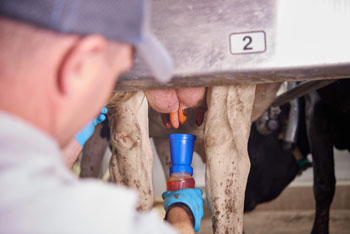Update your milk quality program now to be ready when winter hits.
 Frozen teats? Ouch. Elevated somatic cell counts and clinical mastitis? No, thank you. It’s time to prepare your milk quality program for winter.
Frozen teats? Ouch. Elevated somatic cell counts and clinical mastitis? No, thank you. It’s time to prepare your milk quality program for winter.
“Healthy teat skin is crucial to help cows fend off intramammary infections,” says Keith Engel, GEA dairy farm hygiene and supplies specialist. “By addressing winter weather and teat skin condition before the temperatures drop, you can minimize damage and loss of profitability from elevations in somatic cell count levels.”
Some secrets don’t have to be kept quiet. Here are five ways to help keep teats healthy in winter:
1. Precondition the skin
Teat skin thickness changes rapidly during extreme temperature changes.
“Increasing the level and number of emollients in your post dip well before winter can help precondition teat skin by making it more pliable and ready for weather changes,” says Engel.
A chlorine dioxide teat dip containing lactic acid can help exfoliate the teat skin to slough off excess keratin. This type of teat dip helps reduce hyperkeratosis and prepare teats for colder temperatures.
“Smoother teat ends also harbor fewer bacteria and are easier to clean,” says Engel.
2. Develop a winter teat dip plan
Using the appropriate post dip to help control mastitis is just as essential in the winter as it is during summer. Emollients are a critical ingredient in winter teat dip.
“Emollients help protect, heal and soften skin in harsh winter elements,” says Engel. “A successful winter teat dip should also include an effective germicide proven to kill mastitis-causing bacteria.”
- As soon as the weather starts transitioning to cooler temperatures: Use a post teat dip containing a higher level of emollients with the proper protection against mastitis.
- When weather hits below freezing: Use a winter teat dip with a high level of emollients (74 to 76 percent) with a low enough freezing point to protect your cows.
3. Maintain equipment and optimize automation
When your milking equipment runs smoothly, it is more efficient for your dairy and more comfortable for your cows. To keep your equipment performing it’s best, work with your dealer to schedule routine service checks.
“Make sure to confirm equipment settings are optimal for your cows’ milk production and your liners,” says Engel. “Vacuum and pulsation level settings too low or too high increase teat stress and aggravate teat ends. Check your detacher settings so they are not too low with your milk flow rate. If settings are too low, they can cause excessive compression on teat ends.”
4. Review milking procedures
Milking procedures help maintain healthy teats and harvest high-quality milk. The ideal milking procedure includes appropriate stimulation, milk letdown time of 90 to 120 seconds, clean teats and proper unit attachment and alignment.
“Take time to educate your milkers about the effects winter weather can have on teat tissue. Since hyperkeratosis can be higher in winter, soil traps on teat ends more,” says Engel. “To ensure suitable cleanliness, have milkers wipe teats in a downward, twisting motion. Then flip the towel to a clean area and make a second slightly more aggressive wiping pass across teat ends.”
5. Get the housing environment read
Having the cows’ housing environment ready for winter can help minimize the weather’s impact on teats. Environmental adjustments could include bedding more frequently and using less recycled bedding.
“Adequate bedding is especially important for fresh cows and heifers – udder edema and lower circulation makes them more prone to teat damage,” says Engel. “Fresh, dry bedding is also a key component to preventing environmental mastitis.”
Consider adding wind blocks to help reduce wind speeds and avoid chapping or frostbite. Keep alleys and holding pens clean with frequent scraping.
“By preparing for winter, you can help keep your milk quality on par,” says Engel. “Remember, your milk quality specialists are there to help guide you – reach out to them with questions or advice so you can be sure your farm is profitable all year long.”









